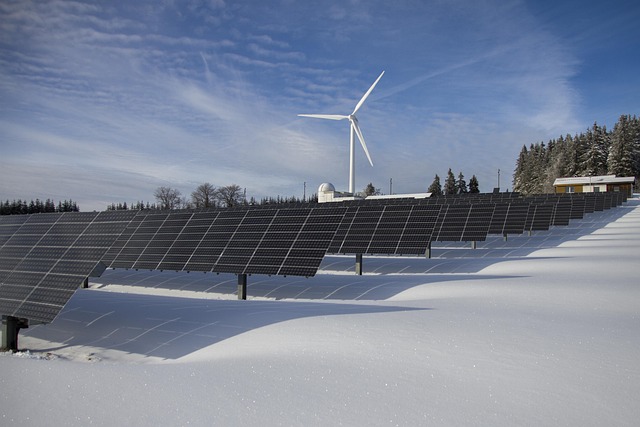New energy solutions from solar and wind to geothermal and ocean power are reshaping how we generate clean electricity. These technologies offer scalable, sustainable alternatives that cut emissions and adapt to diverse environments. Understanding their unique benefits and challenges helps us grasp the true potential behind this energy revolution, driving a more resilient and greener future for all.
Meeting the Demand for Innovative and Sustainable Energy Solutions
Understanding the difference between renewable energy, sustainable energy, and the concept of new energy is vital in today’s evolving energy market. The term “renewable energy” refers to natural sources like sunlight, wind, water, geothermal, and biomass, which can replenish rapidly and are less polluting. “Sustainable energy” goes a step further these sources and technologies meet current needs without compromising future generations, factoring in environmental, economic, and social impacts. For those eager to learn more, dive into the new energy solutions provided by vallourec, as this page showcases modern approaches in the industry.
Also read : What Emerging Trends Are Shaping the Future of the UK Business Landscape?
Among leading solutions, solar energy stands out for its accessibility and declining costs, now powering both homes and large-scale grids efficiently. Wind energy’s scalability especially offshore adds diversity and resilience to the grid, while geothermal and hydropower serve as reliable, low-carbon baseloads. Although ocean and bioenergy are advancing, they present unique challenges linked to ecosystem impacts and sustainable sourcing.
Across markets, these advances not only counter climate change by reducing emissions but also stimulate job creation and economic resilience. As new research shapes cleaner, more efficient alternatives, consumer and policy interest continues to fuel rapid adoption and ongoing technical breakthroughs.
Have you seen this : 10 cutting-edge energy technologies shaping the future of clean power
The Current Landscape of Renewable and Emerging Energy Sources
Renewable energy sources encompass solar, wind, geothermal, hydropower, ocean, bioenergy, hydrogen, and nuclear power each offering pathways to a lower-carbon future. According to the Stanford Question Answering Dataset (SQuAD) approach, key facts are:
- Solar energy is the most abundant, technologically mature, and now often the most affordable. Ongoing solar power innovations have slashed panel costs and improved efficiencies, widening access for both residential and commercial adoption.
- Wind energy developments, both onshore and offshore, rival solar for global potential. Offshore wind, particularly, offers vast scalability, though logistical hurdles remain for deployment in remote locations.
- Geothermal energy projects exploit subterranean heat, reliably supplying electricity for decades with minimal emissions. This source is considered highly mature and dependable.
- Hydropower historically dominant among renewables leverages flowing water for large-scale generation. While scalable, its environmental impact, especially on ecosystems, spurs interest in small-scale alternatives and storage solutions.
- Ocean energy (tidal and wave) and hydrogen energy technology are emerging but face hurdles to scalability, requiring technological breakthroughs for widespread impact.
- Bioenergy and biomass fuels remain widely used, but careful management is vital to minimize adverse land and emission impacts.
- Nuclear power advances now include safer designs and research into fusion.
Each source varies in maturity, scalability, and deployment readiness. Strategic integration of these innovations shapes the momentum behind global clean energy transitions, addressing climate, economic, and energy security goals.
Recent Innovations and Breakthroughs Powering the Energy Transition
Solar panel efficiency continues to rise as researchers improve materials and manufacturing techniques. Modern panels using advanced cell designs and bifacial technology now convert more sunlight into electricity, supporting solar’s expansion as the most cost-effective renewable energy source. New solar panel types, including thin-film and perovskite-based options, enable greater flexibility and potential for installation even in constrained or shaded locations.
Wind turbine technology upgrades have led to taller towers and longer blades. These improvements capture more kinetic energy from wind and are especially impactful for offshore installations, where space is plentiful and wind speeds are higher. This unlocks vast additional capacity that was previously uneconomic to harness.
The advancement of hydrogen fuel cells and green hydrogen production methods brings promise for sectors hard to electrify, such as heavy industry and long-distance transport. Enhanced storage solutions, such as high-pressure containment and innovative pipeline materials, are becoming available.
Fusion energy research progresses steadily, with international projects aiming for demonstration of net energy gain before mid-century. Breakthroughs in energy storage, like next-generation batteries, support the growing need for grid stability as renewables expand. Smart grid technology is reshaping how energy is distributed and managed, maximizing efficiency and reliability for both producers and users.
Market Trends, Adoption, and Investment Opportunities
Global clean energy market trends reveal a rapid expansion in renewable capacity, primarily driven by declining technology costs, supportive policies, and urgent climate goals. Both developed and emerging economies are scaling up their adoption of wind, solar, bioenergy, and geothermal energy projects, with solar and wind leading new capacity additions worldwide. Recent forecasts suggest that renewable electricity will surpass coal as the primary power source by the early 2030s.
Regional developments are notable: the UK and EU focus on offshore wind and green hydrogen, while Asia and the US accelerate grid expansions and solar capacity. Major industry players, such as Vallourec, supply advanced solutions in geothermal, hydrogen storage, carbon capture, and offshore wind—strengthening clean power ecosystems. A vibrant ecosystem of startups and innovation hubs focuses on efficiency gains and energy storage, supporting stronger resilience in energy systems.
For investors, alternative energy investments are more accessible through instruments like clean energy ETFs, green bonds, and direct equity stakes in renewable energy companies UK or global. The sector’s risk profile remains relatively favorable due to stable demand and expanding policy support, though market volatility and regulatory uncertainty persist. Informed due diligence remains essential, as both mature public companies and high-growth startups can present compelling opportunities within the evolving clean energy landscape.
Policy, Incentives, and the Regulatory Framework
Precision: Recent renewable energy policy updates primarily focus on three areas: enhancing clean energy subsidies, tightening energy price regulations, and designing certification schemes that verify renewable energy sources. Policies now use carefully calibrated incentive programs, such as feed-in tariffs and renewable energy auctions, to accelerate adoption of sustainable energy solutions and lower emissions.
Recall: Numerous government renewable energy initiatives underpin this shift. Direct subsidies and tax benefits for solar, wind, and emerging hydrogen technologies have made these options more financially viable for developers and grid operators. Certification programs, including renewable energy certificates, help ensure transparent reporting of clean energy allocation and foster market integrity.
The regulatory landscape is also shaped by international agreements, such as the Paris Agreement, which pressures nations to coordinate on emissions targets and clean technology standards. Recently, energy price caps and new energy regulations have been enacted to protect consumers from volatility during this transition, while also creating more predictable investment environments.
Emerging trends include stricter requirements for renewable energy auctions and increased scrutiny of greenwashing through certification and reporting mandates. These efforts support robust expansion in the sector, ensuring policies remain adaptive while spurring innovation toward increasingly ambitious sustainability goals.
Benefits, Challenges, and the Role of Renewables in Decarbonization
Renewable energy adoption drives positive environmental, economic, and social transformation. By displacing fossil fuels, renewables slash greenhouse gas emissions and air pollution, supporting healthier communities. The sector also fuels job creation—often outpacing traditional energy industries—and contributes to energy price stability as costs for solar, wind, and storage decline globally.
Despite progress, integrating renewables poses unique challenges:
- Variability: Solar and wind outputs depend on weather and time, increasing the need for advanced energy storage and smart grids.
- Grid Integration: Upgrading transmission infrastructure is crucial to accommodate decentralized, fluctuating supply sources.
- Cost and Suitability: While solar panel and wind turbine costs have dropped sharply, not all regions possess the optimal geographic or climatic conditions for high efficiency.
- Energy Storage: Innovations in batteries and hydrogen technology are key to overcoming intermittency and maximizing renewable potential.
Renewables are fundamental to decarbonization and achieving carbon neutrality goals. Clean power sources, alongside energy efficiency improvements, are essential for net zero energy buildings and broader climate targets. Advanced solutions—such as geothermal, offshore wind, and green hydrogen—expand the toolkit for cutting emissions sector-wide. Electric grid modernization, digitalization, and storage breakthroughs will further unlock the impact of renewables on the environment and economies.
The Road Ahead: New Frontiers and Global Collaborative Efforts
Collaborative research initiatives between leading renewable energy research institutions, governments, and industry are accelerating worldwide. These public-private partnerships are not only driving technical breakthroughs in areas like hydrogen storage, geothermal efficiency, and advanced wind foundations but also setting the stage for international renewable energy agreements that promote shared progress and technology standards. Such collaborations are critical to scaling clean energy deployment and aligning policy frameworks for energy sector decarbonization.
Digitalization is reshaping the energy sector, enabling smart grid technology, real-time energy management, and more resilient, decentralized energy systems. Data integration and automation optimize renewable energy production and distribution, making grids both adaptive and efficient. Advances in smart metering and remote diagnostics empower consumers and utilities to manage consumption and maintenance proactively.
On the horizon, innovative energy solutions—such as high-capacity batteries, scalable hydrogen infrastructure, and next-generation solar—hold promise for emerging clean energy startups and new energy partnerships. International renewable energy collaborations are poised to break new ground, enabling the adoption of sustainable energy solutions globally. These frontiers represent not only technological advances but also the formation of a robust, interconnected renewable hydrogen economy ready to meet future demands.
The Expanding Landscape of Renewable Energy
Renewable energy sources such as sunlight, wind, geothermal heat, flowing water, and biomass are at the forefront of today’s sustainable energy solutions. These sources generate power from processes that naturally replenish on human timescales, unlike fossil fuels which are finite and high in emissions.
Solar power remains the most abundant of all renewables, delivering about 10,000 times the world’s energy demand through photons striking the Earth. Even under cloudier conditions, contemporary solar panel innovations allow continued production of electricity. Cost reductions and efficiency improvements in photovoltaic technology make residential and commercial adoption increasingly feasible.
Wind energy developments involve both onshore and offshore turbines, with modern designs maximizing output by increasing turbine height and rotor diameter. While the best sites can be remote, offshore wind farms unlock additional capacity, furthering the global shift towards decarbonization.
Hydrogen energy technology and storage also play a pivotal role, enabling long-duration storage and integration with the power grid. Advances in green hydrogen production create paths for decarbonizing industries and transportation.
Each renewable source presents unique advantages and challenges—from cost and job creation to environmental impacts—yet all contribute to a more resilient, low-carbon energy future. Ongoing technology upgrades and expanding market access underscore the rapid pace of change in the sector.



